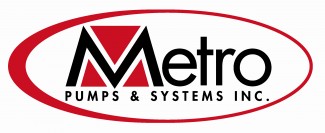
Blog
Vertical Turbine Pumps – Fear of the Unknown Part 3
Posted by: admin | Posted on: November 27th, 2012 | 0 Comments
“Now that I have selected a pump, worked with an application engineer at Metro Pumps and have placed the order, how do I make sure it is installed properly?”
For this installation, we will assume an engineering firm and contractor have completed their work in regard to the wet well and surface piping. The general contractor has completed the masonry work and has installed the mounting rods for the pump as specified. The pump has arrived, has been offloaded properly and we are ready to start the installation process.
It has been my experience one of the biggest mistakes made when installing a vertical turbine pump is not the pump itself, but that of the sole-plate to which it is mounted.
When you inspect the sole plate you should have a machined top side to match the pump discharge head and the other side as formed. This plate will be set over the mounting rods and should be mounted at least 1” above the concrete base. This allows for at least 1” of non-shrinkable grout to be used. Instructions on how to shim and support the sole plate can be found in the manufacturer’s IOM. The sole plate must be leveled and adjusted in order to ensure the pump discharge head centerline will be in-line with the discharge piping.
By the nature of its design, a vertical turbine pump is equipped with sleeve bearings to support the rotating assembly. The only fixed bearings in the entire assembly are located in the motor of the unit. The motor bearings are supplied to accept the thrust and radial loads of the pump. If the pump is not mounted level, the rotating assembly will tend to plumb itself, creating undo forces on the fixed bearings of the motor and will force the pump shaft against one side of the sleeve bearings in the pump. This scenario can cause vibration and early bearing problems both in the motor and the pump.
Leveling of the sole plate should be achieved by using a machinist level or by surveying the site. Do not tilt or offset the pump sole plate to match pre-installed piping. This is a common mistake made by pipe fitters. If it is determined the pipe flange is not square to the sole plate and pump discharge head flange, the pipe should be cut and reconfigured. Once the sole plate is positioned and supported properly, it should be grouted with non-shrinkable grout per the product’s recommended procedures. Once the grout is allowed to cure properly, it is time to install the pump.
Due to the length of vertical pumps, they are shipped horizontally from the factory. Although all the bolting may have been properly torqued at the factory, the pump may have traveled hundreds or thousands of miles to get to the site. It is strongly recommended all bolting and fasteners be checked before installation.
It is extremely important to make sure the rigging crew is aware of how to lift the pump into the vertical position. One of the biggest mistakes is picking the unit from the discharge head and using the suction bell as the pivot point while lifting the equipment. This is where most damage to the equipment occurs. You can find specific information on lifting and installing the equipment in the manufacturer’s IOM.
Once the pump has been lifted into the wet well and landed on the pre-installed sole plate, install all the bolting from the discharge head to the sole plate. Leave all the bolting loose at this time. Confirm the pump is level by using a machinist level on the machined motor flange face on the discharge head. If the discharge pipe flange is installed, make sure the gap for the gasket to be installed is correct and the gap is equal all the way around the flange. If you discover the gap is not correct or the flange is not square to the pump discharge flange, the pipe flange will have to be re-worked. Mating misaligned or flanges with excessive gaps will cause pipe strain and misalignment of the pump shaft.
If everything is square and level, install the gasket and all the bolting on the discharge head flange and make up the discharge flanges. The next step is to tighten all the head to sole-plate bolts.
Our last check to insure proper installation is where the pump shaft comes through the packing or seal box. If the installation and all pump components have been machined properly, the shaft should have equal clearance and be centered in the packing or seal box. It is now time to install the motor and make the pump ready for start up.
I have only described a typical installation. I hope that sharing my experience with installing vertical pumps will assist you with your next installation. As you can see the sole-plate is similar to the foundation of a house or building; if it is not laid properly, you will have problems with the rest of the installation and structure.
Look for more vertical pump information in upcoming e-News issues. If you have any questions in regard to a vertical pump application, please contact us.
Please visit our blog at www.metropumps.com to add comments to the discussion of pros and cons of vertical turbine pumps!
HAVE AN APPLICATION?
Send your request in TODAY to sales@metropumps.com for immediate attention!
About the Author
Vito Gullo has been part of the pump industry for 36 years with experience in all makes and models of pumps and rotating equipment. He has worked for major pump manufacturers as well as distribution. He is currently the President of Metro Pumps and Systems.
Email vgullo@metropumps.com for more information.
Additional Reading: Vertical Turbine, Mixed Flow & Propeller Pumps
By: John L. Dicmas
Published By: McGraw Hill




